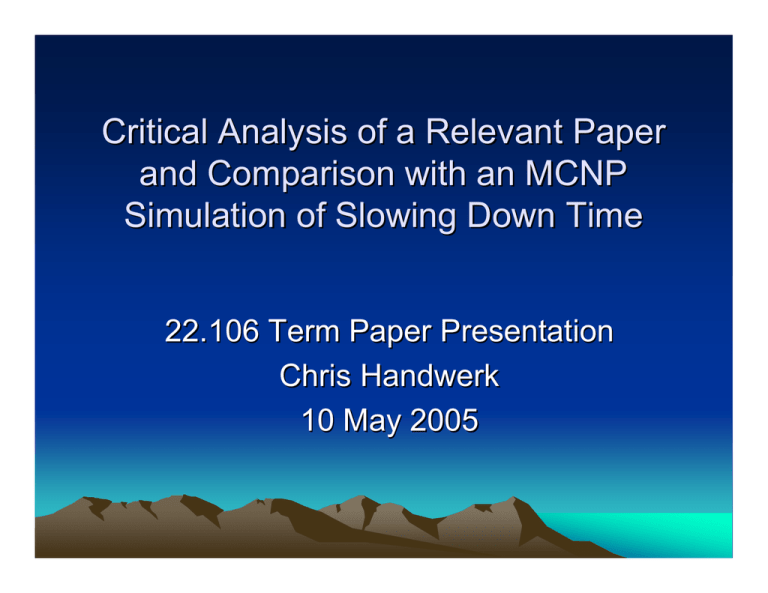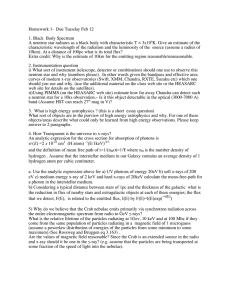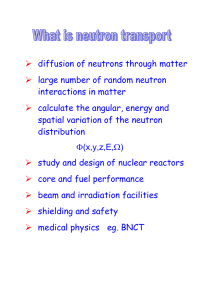Critical Analysis of a Relevant Paper and Comparison with an MCNP
advertisement

Critical Analysis of a Relevant Paper and Comparison with an MCNP Simulation of Slowing Down Time 22.106 Term Paper Presentation Chris Handwerk 10 May 2005 Paper Citation Benyon, T.D. and Mondal, M. A. W., “The Application of Space-Dependent Multigroup Theory to the Analysis of Neutron Slowing Down Time Experiments I: Light and Heavy Water Moderators,”1971, J. Phys. D: Appl. Phys., 4, 1843-1855. Focus • Introduces new numeric solution method • Solution of Neutron Transport Equation (NTE) – P1 Approximation – Diffusion Approximation • Comparison with experimental results (3) – Metric: Neutron Slowing Down – Only 1 presented here • MCNP simulation results for 1st experiment Energy Multigroup Method (Method A) EHI Energy Group EHI ΣαΦα ELOW g g+1 g+2 Σg Φ g Σg+1Φg+1 Σg+2Φg+2 g+3 N Σg+3Φg+3 ΣN Φ N Energy Multipoint Method (Method B) Σα+1Φα+1 Σα+2Φα+2 Σα+3Φα+3 ELOW Σα+4Φα+4 ΣΘ Φ Θ Mixed Energy Multigroup/Multipoint Method (Method C) EHI g Σg Φ g g+1 Σg+1Φg+1 g+3 ΣαΦα Σα+1Φα+1 ΣΘΦΘ Σg+3Φg+3 N ELOW ΣN Φ N • • • • Experiment #1 Möller (1966) 1 m3 cube H2O Dilute Indium Sulfate Fast neutron source Image removed due to copyright considerations. Please see: Experiment # 1 graph cited from: Benyon, T. D., and M. A. W. Mondal. “The Application of Space-Dependent Multigroup Theory to the Analysis of Neutron Slowing Down Time Experiments I: Light and Heavy Water Moderators.” J. Phys. D: Appl. Phys. 4 (1971): 1843-1855. Image removed due to copyright considerations. Experiment #1 Comparison with MCNP Simulation Please see: Experiment # 1 comparison graph cited from: Benyon, T. D., and M. A. W. Mondal. “The Application of SpaceDependent Multigroup Theory to the Analysis of Neutron Slowing Down Time Experiments I: Light and Heavy Water Moderators.” J. Phys. D: Appl. Phys. 4 (1971): 1843-1855. Possible Sources of Discrepancy Numeric Soultion/Experiment MCNP Simulation Quantity Measured Gamma flux from (n,γ) capture in Indium Neutron Flux Detector Type Gamma Point Flux tally Detector Distribution ?? Concentric Spheres Source Isotropy ?? Yes Conclusions • New method (C) matches experimental results well when applied to P1 approximation • MCNP simulation results differ at greater distances from source • Unearthing error will provide greater insight into original solution/experimental methods or simulation model • • • Experiment #2 Chen and Lidofsky (1967) “Large tank of water” 14.1 MeV neutron source Images removed due to copyright considerations. Please see: Experiment # 2 graph cited from: Benyon, T. D., and M. A. W. Mondal. “The Application of SpaceDependent Multigroup Theory to the Analysis of Neutron Slowing Down Time Experiments I: Light and Heavy Water Moderators.” J. Phys. D: Appl. Phys. 4 (1971): 1843-1855. Experiment #3 • Möller (1966) • 1 m3 cube D2O • Fast neutron source Image removed due to copyright considerations. Please see: Experiment # 3 graph cited from: Benyon, T. D., and M. A. W. Mondal. “The Application of SpaceDependent Multigroup Theory to the Analysis of Neutron Slowing Down Time Experiments I: Light and Heavy Water Moderators.” J. Phys. D: Appl. Phys. 4 (1971): 1843-1855. Normalized Flux) Normalized Flux as a Function of Time at 4 cm 1.06E+00 1.01E+00 9.60E-01 9.10E-01 8.60E-01 0.6 0.7 0.8 0.9 1 Time (microseconds) 1.1 1.2 Normalized Flux) Normalized Flux as a Function of Time at 8 cm 1.06 1.01 0.96 0.91 0.86 0.6 0.7 0.8 0.9 1 Time (microseconds) 1.1 1.2 Normalized Flux) Normalized Flux as a Function of Time at 12 cm 1.06E+00 1.01E+00 9.60E-01 9.10E-01 8.60E-01 0.6 0.7 0.8 0.9 1 Time (microseconds) 1.1 1.2 Normalized Flux) Normalized Flux as a Function of Time at 16 cm 1.06E+00 1.01E+00 9.60E-01 9.10E-01 8.60E-01 0.6 0.7 0.8 0.9 1 Time (microseconds) 1.1 1.2 Normalized Flux) Normalized Flux as a Function of Time at 20 cm 1.06E+00 1.01E+00 9.60E-01 9.10E-01 8.60E-01 0.6 0.7 0.8 0.9 1 Time (microseconds) 1.1 1.2








